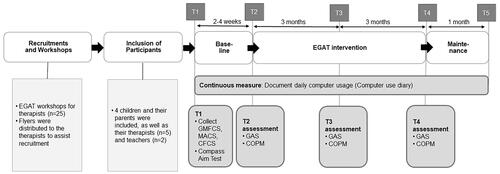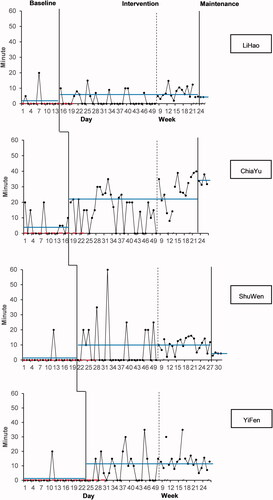Figures & data
Figure 1. The study procedure and measurements at each time point. Note. T1= the beginning of the baseline phase. T2= before the intervention started. T3= at the three-month intervention, T4= at the six-month intervention, T5= one-month after the intervention ended. GMFCS = Gross Motor Function Classification System; MACS = Manual Ability Classification System; CFCS = Communication Function Classification System; GAS = Goal Attainment Scaling; COPM = Canadian Occupational Performance Measure. The study began with a workshop for therapists and participant recruitment. Then, the included participants were involved in a procedure, with a two to four-week baseline, followed by a six-month intervention and a one-month maintenance phase. The figure also presents the measurements conducted from T1 to T5.

Table 1. Participant characteristics, baseline and intervention context.
Table 2. The EGAT intervention content.
Figure 2. Duration of participation in computer activities for each participant. Note. Data were aggregated from daily to weekly average after 50 days because of space constraints. Zero performance days of data mean that the computer was available, but the participants did not use it. A hatch mark (//) indicates interruption (that is days when the intervention was usually followed but there was no opportunity because the computer was not available to the children). Horizontal solid line (blue) = level (mean) at each phase. Horizontal dash line (red) = split middle trend line at baseline. This graph displayed that ChiaYu, ShuWen, and YiFen showed a clear level (mean) change from baseline to the intervention phase, and the immediacy of effects was evident. LiHao only showed a small level change across phases, and there was no immediacy of response to the intervention.

Table 3. Computer usage at baseline and the intervention phases.
Table 4. GAS scores and the score changes of the performance and satisfaction scales of COPM at T3 and T4.
Appendix Individualised content of EGAT use at the beginning and the end of the intervention phase
